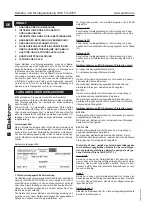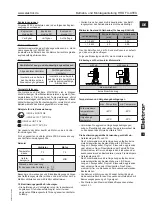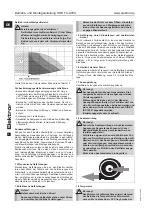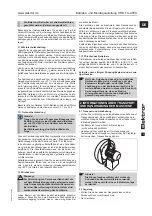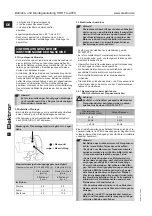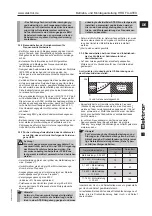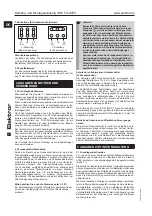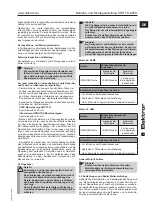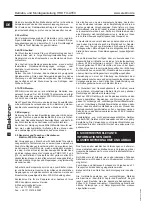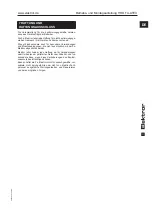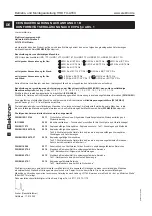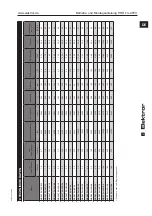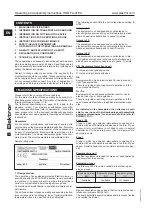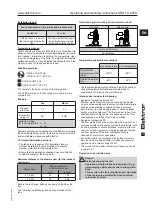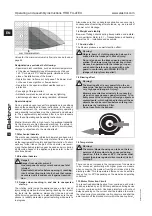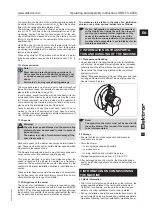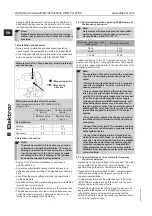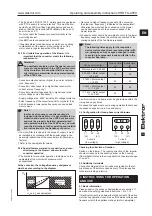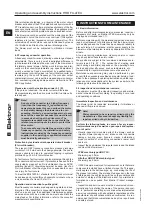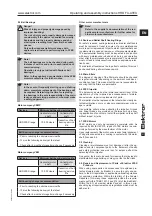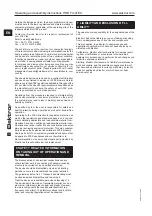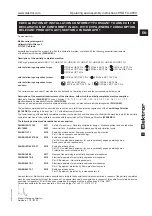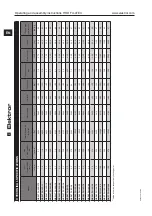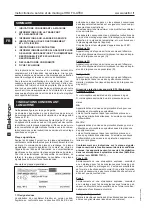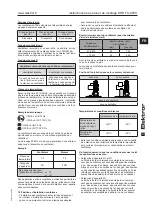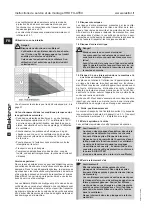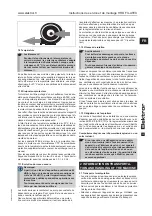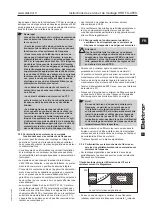
16
EN
Operating and assembly instructions HRD FU-ATEX
www.elektror.com
9016330 01.20/08
1
Values for the minimum volumetric
fl
ow rate can be found at
page 24.
Designated use excludes the following:
• Special ambient conditions, such as ambient temperature
at the place of assembly/use at temperatures of above
+40 °C or below -20°C, dust deposits, vibrations at the
place of installation/use of the blower.
• Operation near / in
fl
ames or hot gases. The blower must
not be used as an ignition or
fl
ame arrester.
• Operation in the open air without weather and sun
protection.
• Conveying of foreign matter.
• Adiabatic compression and shock waves, lightning,
electromagnetic waves, ionising radiation, ultrasound.
Special designs:
Can be provided upon request for applications in conditions
beyond those described in these instructions. In the case of
special equipment, the enclosed supplementary operating
and assembly instructions must be observed and adhered
to. The supplementary instructions di
ff
er in certain respects
from these Operating and Assembly Instructions.
Elektror blowers o
ff
er a high level of operational reliability.
As the blowers are high-powered machines, the safety in-
structions must be strictly observed in order to avoid injuries,
damage to objects and to the machine itself.
1.3 Mechanical hazards
The mechanical hazards in Elektror blowers have been mini-
mised in accordance with the current state of the art, as well
as the requirements for safety and health protection. To elimi-
nate any further risk on the part of the operator, we recom-
mend that suitable protective gear be used and worn during
all lifecycle phases of the appliance (please refer to the in-
structions below).
1.4 Electrical hazards
Danger!
Danger from electric current!
Live components carry current and cause fatal
injuries!
Deactivate the device before opening it, reaching
into it or inserting tools into it; check that compo-
nents are not live and secure it against reactiva-
tion.
1.5 Danger when reaching in and due to unexpected
start-up
The rotating parts inside the appliance pose a high risk of
injury during operation. Before opening, reaching in or insert-
ing tools into the appliance, always shut it down and wait
until all moving parts come to a standstill. Make sure the ap-
pliance is reliably protected against restarting while work is
in progress.
Also make sure that no hazardous situation can occur as a
consequence of restarting after shutdown, e.g. as a result of
a power cut or blockage.
1.6 Weight and stability
Beware of falling hazards during transportation and installa-
tion in particular. Refer to 2.1 – Transportation and handling,
as well as 3.2 – Installation and assembly.
1.7 Suction e
ff
ect
The blowers produce a powerful suction e
ff
ect.
Warning!
Objects, items of clothing and also hair can be
sucked into the intake port. Risk of injury!
Do not stand near the intake opening during op-
eration. The blower must not under any circum-
stances be operated with the intake port open,
and should, therefore, be covered with a wire
guard in conformity with DIN EN ISO 13857
(danger of injury from impeller!).
1.8 Blowing e
ff
ect
Warning!
The blowing e
ff
ect is very powerful on the ex-
haust side. Sucked in objects may be ejected at
very high speed (danger of injury).
Blowers are suitable exclusively for conveying
clean air or pure gaseous gas-air mixtures. To re-
liably prevent the sucking-in of foreign objects or
contaminants, which might be discharged, these
objects have to be removed before entering into
the blower by installing a
fi
lter.
Do not reach into the exhaust.
1.9 Temperature
Warning!
The motor-/blower housing can take on the tem-
perature of the medium to be conveyed during
operation. If this is above +50°C, the owner must
protect the blower against direct contact (risk of
burning!).
There can be an increase in the temperature of the medium
to be conveyed, particularly with higher pressure models,
when conveying the medium from the air intake side to the
discharge side. This temperature di
ff
erence can lie within a
range of up to +20°C depending on the model and operating
conditions.
1.10 Motor Protection Circuit
To prevent inadmissible heat-up from overload, each motor
shall be protected by an ATEX-compatible monitoring device
or motor overload switch. Overload protectors with cut-out
delay depending on the current shall be installed to monitor
the rated current consumption in all conductors and shall be
able to switch o
ff
the blocked motor within the heat-up time t
E
.

